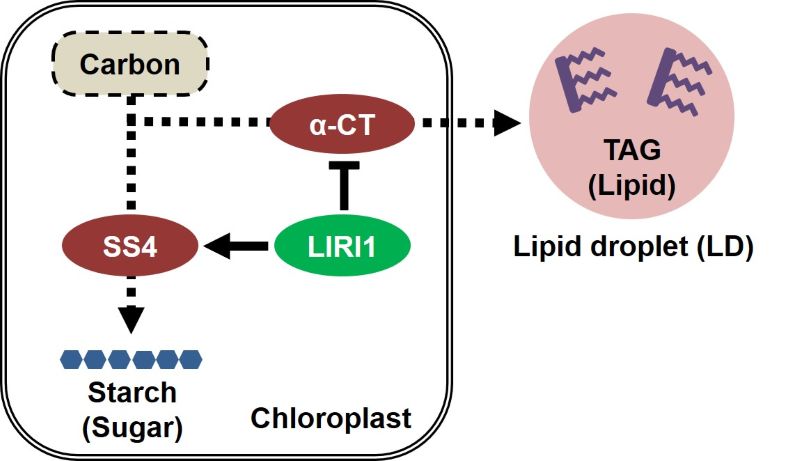We reach more than 65,000 registered users in Dec!! Register Now

Forward Genetics Approach Reveals the Factor Responsible for Carbon Trade-Off in Leaves
- July 09, 2025
- 1 Views
- 0 Likes
- 0 Comment
Starch and oils are known as storehouses of carbon in plants. However, the way in which carbon resources are allocated during metabolism in plants remained unknown. Now, however, using a forward genetics approach, researchers have identified that a gene named LIRI1 regulates this process, significantly increasing oil storage in leaves while reducing starch levels. Their findings provide insights into carbon allocation mechanisms, offering the potential for the development of renewable biofuel resources or low-starch foods.Study reveals how plants balance starch and oil production in leaves, opening new possibilities for sustainable biofuel production and oil-rich carbon resources

Plants store carbon in two primary forms: starch and triacylglycerols (TAGs). Starch is mainly stored in chloroplasts in leaves, where it serves as a readily available energy source, while TAGs are stored in seeds for long-term energy storage. Past studies have shown that a carbon trade-off exists between these two storage forms, implying that an increase in the levels of one form often reduces the levels of the other. Interestingly, attempts to increase TAG in leaves have led to a decrease in the levels of starch, suggesting that plants regulate carbon sources, prioritizing either starch or TAGs. Understanding this trade-off could lead to the development of plants with more TAG in their leaves, providing a sustainable source of plant oils.
Now, in a study published in the Journal of Experimental Botany on February 8, 2025, researchers from Chiba University, Japan, provide new insights into the factors controlling this carbon trade-off. Their findings reveal that a previously unreported gene –named LIRI1 –which encodes an unknown protein, plays a crucial role in regulating the balance between starch and lipid storage in plant leaves by influencing both fatty acid and starch biosynthesis pathways.
Led by Associate Professor Takashi L. Shimada, with Ms. Mebae Yamaguchi as the study’s first author, from the Graduate School of Horticulture, Chiba University, the research team used a forward genetics approach to identify the genes responsible for altered carbon storage patterns. They screened mutant Arabidopsis plants that exhibited higher leaf TAG levels and lower starch content, eventually identifying LIRI1 as a key regulator.
Talking about the rationale behind this study, Associate Professor Shimada says, “We were interested in how plants allocate carbon resources. Particularly, why do seeds accumulate so many lipids while leaves contain very little? Answering this question through our research has helped us contribute to both basic and applied science.”
Instead of directly measuring the TAG content in leaves, which would be time-consuming, the researchers counted the number of lipid droplets (LDs) that store TAG in the leaves. To develop the mutants, the researchers treated Arabidopsis seeds with ethyl methanesulfonate, a chemical mutagen that induces random DNA mutations. The seeds carried a transgene encoding green fluorescent protein fused to CALEOSIN3, a protein that naturally localizes to LDs. This fluorescent tagging allowed the researchers to visualize LDs in the leaves of the seedlings under a fluorescence microscope. Among the screened plants, they discovered a mutant named lipid-rich 1-1 (liri1-1), which had five times more TAGs and half the starch content of wild-type plants.
List of Referenes
- Mebae Yamaguchi, Shuji Shigenobu, Katsushi Yamaguchi, Yasuhiro Higashi, Yozo Okazaki, Kazuki Saito, Emi Mishiro-Sato, Keiko Kano, Ryosuke Sugiyama, Mami Yamazaki, Shigeo S Sugano, Shuichi Fukuyoshi, Haruko Ueda, Ikuko Hara-Nishimura, Takashi L Shimada. LIPID RICH 1 modulates allocation of carbon between starch and triacylglycerol in Arabidopsis leaves. Journal of Experimental Botany, 2025; DOI: 10.1093/jxb/eraf048
Cite This Article as
No tags found for this post









